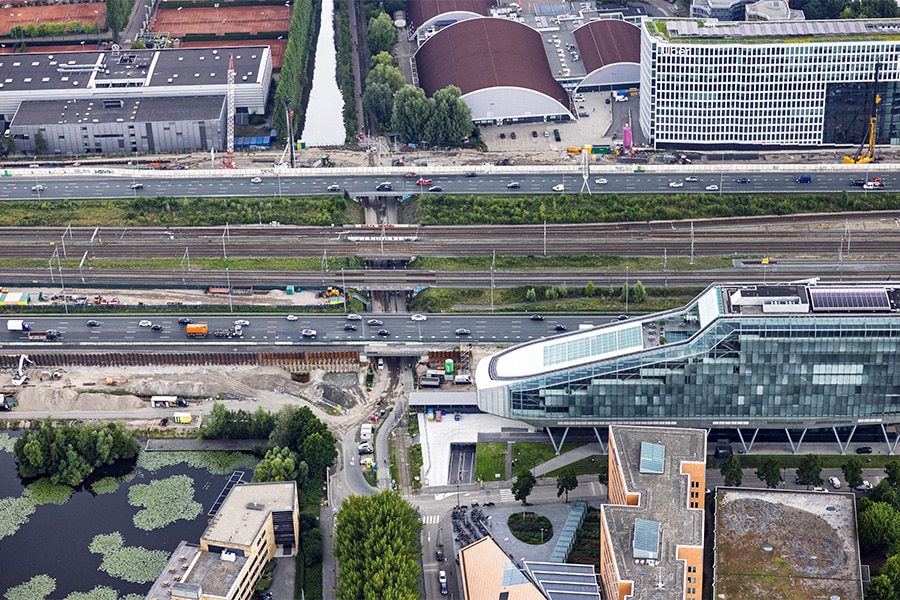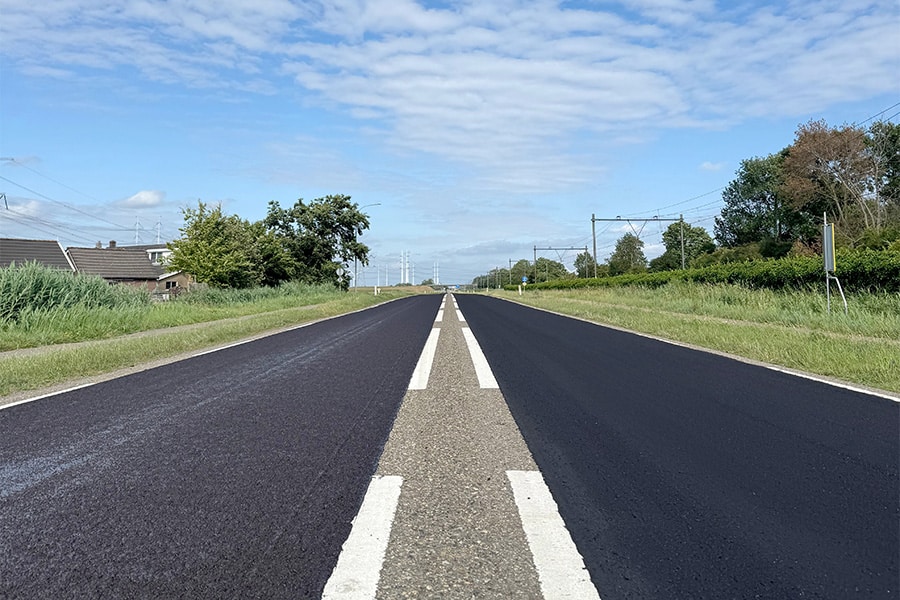
Renovation of historic platform caps Leeuwarden station
It must have been a mighty sight for the people of Leeuwarden when in 1863 the NS 600 steam locomotive (built in Manchester) puffed and blew off steam next to the brand new platform. Leeuwarden Station was put into operation on October 27, 1863 with the opening of the Harlingen - Leeuwarden railroad line. In 1866, the line was extended to Groningen. In 1868, the Zwolle - Leeuwarden connection was also completed. The railroad line Leeuwarden - Stavoren was put into operation in 1883-1885 as part of the connection between Amsterdam and the Frisian capital.

Finally, in 1901 another railroad line was established from Leeuwarden in a northerly direction. Leeuwarden Station meant a leap forward for Friesland and the Netherlands in the mobility of people and goods. Not only the function of the station, but also the building itself are of historical value. Reason enough for ProRail to subject this beautiful station to a thorough renovation in 2021. The historic platform roofs will be replaced, with all associated and surrounding work. Of course with the knowledge and resources of today, but true to the historical features.
Platform caps de dato 1891
We speak with Jim van Leersum, Project Manager Stations & Transfer at ProRail and Peter Bos, Project Manager at Anton Rail & Infra BV, the main contractor. Van Leersum opens the conversation, "The renovation concerns the platform caps and everything that goes with them. Leeuwarden station was expanded and rebuilt around 1891, during which the platform covers were realized. It concerns the high canopy, over the platform square and the low canopies on the first three platforms. Leeuwarden Station has mainly end tracks (An end track is a dead-end track through which the train can only continue by going back over the arrival track in the opposite direction). Where all tracks converge, that is where the high roof begins. On the first three platforms are the low roofs, constructionally it is one whole. All platforms are largely roofed."

The platform covers are supported by cast-iron columns and trusses of welt iron, a type of wrought iron. "The rest is cast iron," Van Leersum continued. "The whole thing has been labeled a national monument. That means we are going to reuse as much material as possible and bring everything back to as original a state as possible - that is, visually returned to 1891. Some parts will be copied in cast iron, the parts that can be reused will be sandblasted after disassembly, repaired if necessary and preserved again. The roof is wooden and probably originally had a zinc roofing. After World War II, this zinc roof was replaced by a bitumen roof. However, the new roofing will be of EPDM, a sustainable alternative."

War damage to the hood
Responsible for the uprights, trusses, timber, roofing and foundation is general contractor Anton Rail & Infra BV. Peter Bos and his team and the subcontractors started removing the low caps in the summer of 2020. "This was completed just before Christmas," Bos explains. "The first three phases, the platforms, are done in terms of dismantling. Now we have started the removal of the high canopy and the work necessary for the restoration and new fabrication of all the elements is taking place in various places."
Van Leersum tells a historical anecdote about the war damage to the hood: "The station master on duty, Mr. Blijham, had been assigned an important task in World War II. When the Germans invaded, the track had to be disabled. When that time came, he tied a locomotive to the hood structure in order to pull the hoods onto the track.
This story came to light after damage was found to one of the columns during inspection. We will not repair this damage, but rather preserve it, with a reference to this historical event. We will pay due attention to it, with a memorial. We will work constructively around the damage."

New structural calculations eliminate old design flaws
According to Van Leersum, it is a challenge to calculate the new cap close. "We have new standards and we know a lot more. The original construction had design flaws, for example, no account was taken of the suction effect of the wind, no account was taken of expansion and contraction of materials. Some columns broke as a result. By building very robustly, everything was able to last 130 years. It goes without saying that we do take these factors into account now."

Working 'with the store open'
For Anton Rail & Infra, environmental management is a big job. "If there had been no corona, we would have had about 20,000 people on our construction site every day. Now there are fewer, but still a lot. ProRail wants to keep the station open as much as possible, with as little disruption to travelers as possible. That requires a good piece of environmental management," Bos said. "It is a dynamic project that touches all disciplines, from underground infrastructure, track work, the station itself to station management. Through good coordination with all parties involved and by working in phases, we will reach the finish line together in the desired way."
Anton Rail & Infra took on the project in April 2020. "The first contact between the teams took place at the end of April, and work began in early May," Bos says. "First, a foundation survey was conducted. A trial trench was dug and at the same time, cable and pipe clearance of platform 1 was started. On June 24, Platform 1 was taken out of service, after which dismantling of the platform covers began. The head tracks were pulled back and in 7 weeks the canopy was dismantled. In early August it was platform 2's turn, and in early October platform 3. This was completed in mid-December, meaning that platform 3 could also be put back into use, completed with excavation, cables and pipes removed, space for our foundation, concrete foundation using the existing wooden pile construction, including a steel tube around the wooden piles, against ground water. On the top of the piles we will strike dowels, which will be connected to the concrete structure. There will be a precast girder across the entire width of the platform, to which the piles will be connected. Then we can close the platform.

Nine-month recess for steel construction
The dismantled steel structure has now entered a 9-month recess. Time needed for research, inspection, sharing research results with the engineering firm and passing on damages found. "We are cooperating with Movares in this, they guide us in everything," Bos explains. "In the end, we know exactly how much is still reusable, what needs to be done to renovate these parts and which parts need to be replicated. The rejected parts are recast, with special molds that are made following measurement work and calculations."

The search for the original paint color
Just to show how seriously history is taken, there is no finer example than the paint survey that was conducted. Van Leersum: "At every stage of disassembly, we looked for painted metal parts that had never been touched by the many paint brushes that had passed over them over the past 160 years. Finally, after thorough research, we emerged with a clear paint history. The oldest paint color we found is a pine green common for the time. This color has now been submitted to the National Historic Landmarks Commission."

Bos concludes, "This is not 'business as usual' for us either, given the history that must be respected. But all the more beautiful for that. We encounter many unexpected issues during the work, but through proper consultation, a solution is found for everything. Our common goal is to make everything future-proof, with a view as if you were standing on the platform in 1891. We will succeed, thanks to the good partnerships we have formed in this project."




